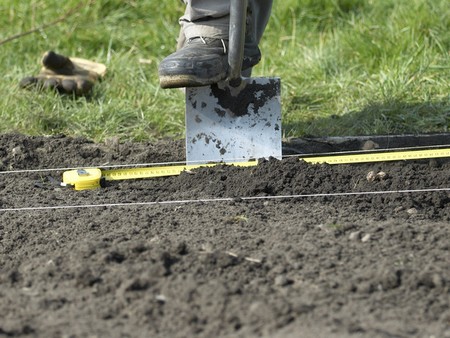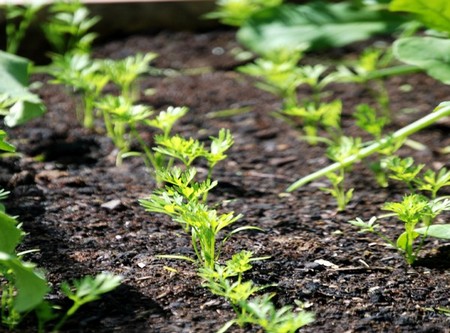Best Way to Prepare the Best Soil for Growing Vegetables
Digging is the traditional method for clearing a vegetable plot at the end of the season and preparing it for the next. But organic gardeners question the need for annual digging, pointing out that it destroys the soil’s natural structure and can bring a fresh crop of weed seeds to the surface. Digging is often impractical when growing vegetables among other plants. Whether you dig every year, every few years or not at all depends on where you are growing your vegetables, and on the underlying soil.
Breaking new ground
When starting off a new vegetable plot or constructing raised vegetable beds, it is advisable to prepare the ground thoroughly. Digging breaks up compacted soil, improving drainage and aeration. At the same time, you can remove perennial weed roots and incorporate bulky organic matter.
It is worth taking your time digging over a new vegetable plot, and doing a thorough job. First dig a hole at least 45cm deep. If there is a hard layer below the surface that could impede drainage, this should be broken up by double digging. If the soil is fairly loose and free-draining, single digging should suffice.
Annual digging
Some gardeners still prefer to dig over the vegetable plot each winter. On a heavy clay soil, aim to complete digging by Christmas. Try to invert each lump of soil to bury annual weeds, but leave the clods intact. The action of frost and rain will break down the clods to leave a crumbly soil by spring. On light, sandy soils, wait until spring before digging. Often a hard crust forms on the surface over winter, and this needs to be broken up before sowing or planting.
If you need to lime part of the plot, do this in autumn/winter. It may be convenient to incorporate bulky organic matter in the autumn or winter, but most of the nutrients are likely to be washed out by winter rain.
It is better to add organic matter as a surface mulch in the spring, so the nutrients benefit your crops.
To look after your back, spread the digging over several sessions.
Mulching
Spread organic matter on the surface of the soil in a deep layer, preferably at least 5cm thick. If applied in sprin (March), it will prevent weed seeds germinating and help to retain moistu within the soil. In time, earthworms will drag the mulch down into the soi so you do not need to dig it in. You will need to reapply mulch every spring. Mulching cannot tackle underlying problems such as compaction, but it will help to mainta a well-structured and fertile soil.
Bed systems
If you divide the plot into beds, in whi the crops grow, and paths, on which you walk, the soil does not get compacted, so you do not need to dig. Add organic matter to the surface of the soil. Light cultivation, such as raking and hoeing, are all you need to do each year.
Trenching
Preparing a trench can help in two ways. It can increase the moisture retention of the part of the vegetable plot where runner beans or other moisture-sensitive crops are to grow. It is also a convenient way to dispose of tough crop remains that are slow to rot down in the compost heap. Dig a trench about 60cm wide and about 30cm deep in the autumn.
Fill it over winter with crop debris, manure, old growing-bag compost, etc, and gradually replace the topsoil. Leave it to settle before planting in spring.
Planting holes
The same principle as trenching applies, but on a smaller scale. Dig a hole about 30cm deep and 30cm across for one plant, such as a courgette, and incorporate plenty of organic matter into the soil at the bottom of the hole before refilling with soil. This is useful when planting moisture-sensitive crops into an established border.
Categories
Advertisements
Recent Articles
 How to Understand Bed Sizes – A Small Guide
How to Understand Bed Sizes – A Small Guide How to Select Some Must Have Kitchen Accessories
How to Select Some Must Have Kitchen Accessories Best Way to Change a Car Tire
Best Way to Change a Car Tire Best Way to Write an Affirmation
Best Way to Write an Affirmation Best Way to Take Charge of Your Financial Life
Best Way to Take Charge of Your Financial Life Best Way to Survive a Party When You Don’t Know Anyone
Best Way to Survive a Party When You Don’t Know Anyone Best Way to Stop Self Sabotaging Yourself
Best Way to Stop Self Sabotaging Yourself Best Way to Start Journal Writing
Best Way to Start Journal Writing Best Way to Speak with a Powerful Voice
Best Way to Speak with a Powerful Voice Best Way to Simplify Your Life
Best Way to Simplify Your Life Best Way to Respond to a Put-Down
Best Way to Respond to a Put-Down Best Way to Reduce Acne Breakouts
Best Way to Reduce Acne Breakouts Best Way to Recover from Dining Disasters
Best Way to Recover from Dining Disasters Best Way to Quit Your Job Gracefully
Best Way to Quit Your Job Gracefully Best Way to Make Your Own Website
Best Way to Make Your Own Website



Leave a Reply